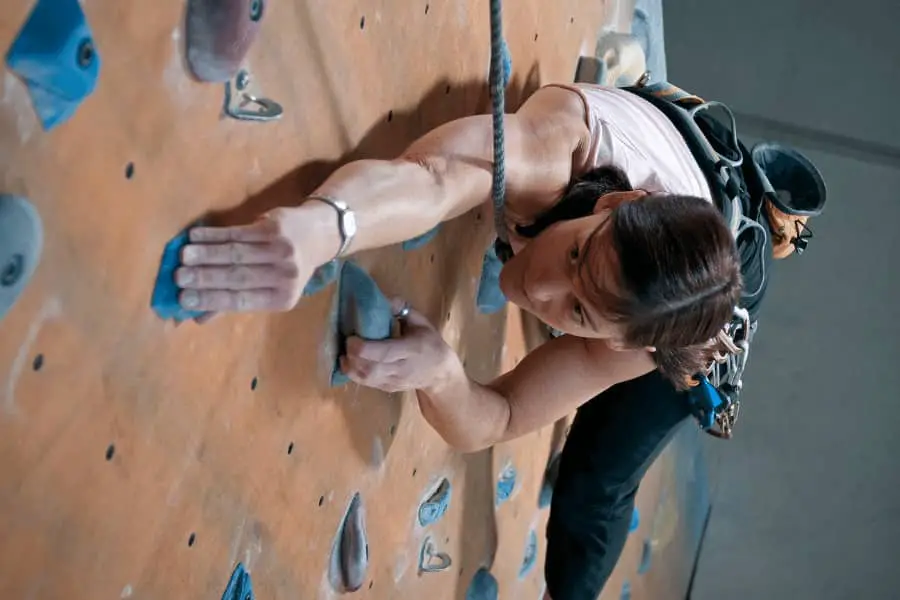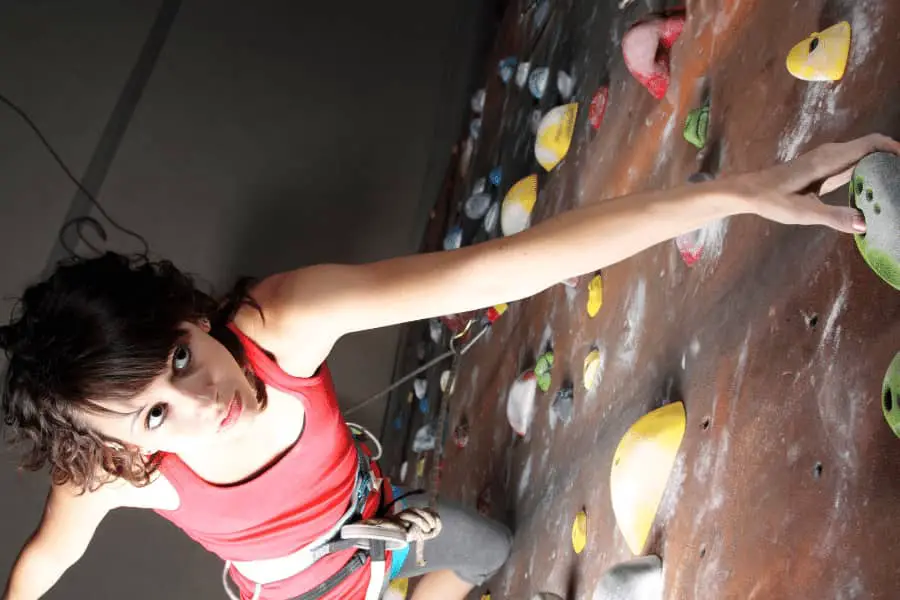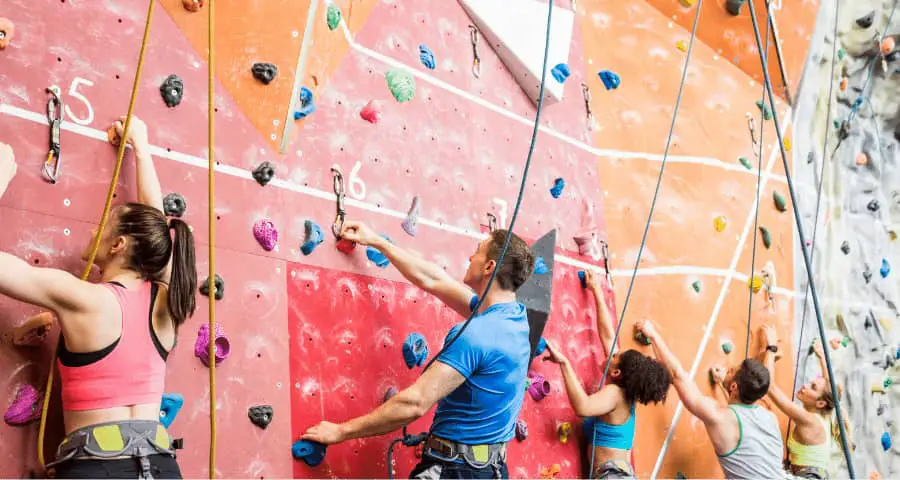
When I first started climbing I had no idea what was considered “good” in climbing. When I finally was able to climb my first 5.11a route, I did some research to figure out how good of a climber I actually was.
Being able to climb a 5.11 is good and means you are an above average climber. The average leisure climber will not be able to climb routes harder than 5.10d with consistency. Competitive collegiate climbers are able to climb between 5.11a and 5.12b on average.
You need to consider multiple variables, not just the grade you are able to climb, when determining if you are a good climber or not. While grades are a helpful benchmark, they do not tell the full story.
If you are interested in seeing what the current prices are for the most popular rock climbing training aids, you can find them on Amazon by clicking here (affiliate link).
How Climbing Grades Measure Climbing Ability
You probably have run into a few different types of climbers by now. My least favorite type of climber is the one who won’t shut up about how they climbed a 5.12c once and acts like that makes them better than everyone else. To put this in perspective, I generated the table below to detail the climbing community’s general consensus on climbing grade difficulty:
Table 1 – How The Climbing Community Generally Views Grade Difficulty
| Climbing Grade | Climbing Grade Difficulty |
| 5.0 to 5.7 | Easy. Most new climbers will be able to achieve this level relatively quickly without any issues. |
| 5.8 to 5.10d | Moderate. Most leisure climbers will be able to achieve this without a major time commitment. |
| 5.11a to 5.12d | Hard. Consistent training and technical ability are required for most climbers to reach this level. |
| 5.13a to 5.15c | Elite. These levels are normally reserved for very dedicated climbers and the professionals. |
I decided to research this topic further and was able to find a research paper published by the International Rock Climbing Research Association (IRCRA) in 2014 entitled Comparative grading scales, statistical analyses, climber descriptors and ability grouping. To read the entirety of the paper, you can access it here.
The research evaluated both male and female climber abilities. Tables 2 and 3 below, detail the findings for the male and female climbers respectively.
Table 2 – IRCRA Climbing Group Ability For Male Climbers
| Climbing Grade | Climbing Group Ability |
| 5.0 to 5.9 | Lower Grade (Level 1) |
| 5.9 to 5.11d | Intermediate (Level2) |
| 5.12a to 5.13b | Advanced (Level 3) |
| 5.13c to 5.14b | Elite (Level 4) |
| 5.14c to 5.15c | Higher Elite (Level 5) |
Table 3 – IRCRA Climbing Group Ability For Female Climbers
| Climbing Grade | Climbing Group Ability |
| 5.0 to 5.9 | Lower Grade (Level 1) |
| 5.10a to 5.11a | Intermediate (Level 2) |
| 5.11b to 5.12c | Advanced (Level 3) |
| 5.12d to 5.14a | Elite (Level 4) |
| 5.14b to 5.15c | Higher Elite (Level 5) |
Based on the research compiled by the IRCRA, climbing a 5.11a as a male puts you in the intermediate climbing ability category and climbing a 5.11a as a female puts you in the advanced climbing ability category. According to the IRCRA, to be considered “advanced” as a male, you would need to be able to climb at least a 5.12a.
How You Compare To Collegiate Climbers

Professional climbers will forever be in a class of their own. They get to spend their entire day improving upon their climbing ability. Comparing ourselves to them is not fair as it will be impossible to stack up to them without some major lifestyle changes.
Collegiate climbers on the other hand are still full-time students and are not able to climb all day, every day. That being said, they are dedicated to what they do and are actively working to improve their climbing abilities. Therefore, I thought looking at the performance of collegiate rock climbing teams would be a great way to see how the average gym climber measures up.
Climbing Ability Of The 2014 Stanford Climbing Team
The Stanford climbing team conducted research back in 2014 to see just how hard their members were able to climb. The research surveyed 28 of the competitive climbing team’s members and found out some pretty interesting statistics. I have compiled the survey results below in Table 4.
Table 4 – Climbing Ability Of 28 Members On The 2014 Stanford Climbing Team
| Top Rope Route Grade | Climbers At That Ability Level | Percent of Climbing Team |
| 5.10b to 5.10d | 5 | 18% |
| 5.11a to 5.11b | 6 | 21% |
| 5.11c to 5.11d | 8 | 29% |
| 5.12a to 5.12b | 6 | 21% |
| 5.12c to 5.12d | 3 | 11% |
The research concluded that the average climber on the Stanford climbing team was able to climb 5.11c routes. Most climbers (71%) on the team were able to climb routes between 5.11a and 5.12b. Only 18% of the team was not able to climb at least a 5.11a.
The survey also concluded that the majority of the climbers are not able to climb as well on lead routes as they are on top rope routes. The research found that on average, climbers lost approximately half a climbing grade of ability when transitioning from top rope to lead routes. For example, if a climber is able to top rope a 5.11d, then they would only be able to lead climb a 5.11b. This drops the average climbing ability from 5.11c to 5.11a for lead climbing routes.
You can click here to check out the complete research conducted by the Stanford climbing team. The research covers more topics than just the ones I have presented above. It compares different types of climbers and evaluates how well top rope ability, bouldering ability, and lead climbing ability compare among other topics.
Climbing Ability Of The 2020 UT Austin Climbing Team
The climbing team at the University of Texas at Austin (UT Austin) was inspired by the research conducted by Stanford’s climbing team and decided to conduct their own. UT Austin’s climbing team is competitive and individuals have to try out to join. That being said, here is the average breakdown of their climbers:
“We’re for the most part typical casual climbers, however (don’t be fooled by our previous national champion status). Most us started climbing in college, having done it for 1-4 years, and climb/compete more as a casual hobby than anything else. Most of us climb 2-3 times a week and are in it mostly recreationally.”
Nathan Wu, UT Austin Climbing Team Member
Nathan Wu, a member of UT Austin’s climbing team, surveyed 33 of his fellow climbing team members to conduct the research. One of the topics surveyed was climbing ability. Table 5 below details how the numbers shook out:
Table 5 – Climbing Ability Of 31 Members On The 2020 UT Austin Climbing Team
| Route Grade | Climbers At That Ability Level | Percent Of Climbing Team |
| 5.10a to 5.10b | 6 | 19% |
| 5.10c to 5.10d | 2 | 6.5% |
| 5.11a to 5.11b | 7 | 23% |
| 5.11c to 5.11d | 6 | 19% |
| 5.12a to 5.12b | 7 | 23% |
| 5.12c to 5.12d | 2 | 6.5% |
| 5.13a | 1 | 3% |
The results of the UT Austin climbing team survey were consistent with those of the Stanford climbing team. The research concluded that the average climber on the UT Austin climbing team was able to sport climb 5.11a. Most climbers (65%) on the team were able to climb routes between 5.11a and 5.12b. Only 25.5% of the team was not able to climb at least a 5.11a.
You can click here to look at the complete research conducted by UT Austin’s climbing team. The research covers more topics than just the one I presented above. It evaluates how well sport climbing ability, bouldering ability, height, and BMI compare among other topics.
What Actually Makes You A Good Climber

Climbing grades should only be used as a reference benchmark for your climbing ability. There are a lot of other factors that go into making a person a good climber. Some climbers have a lot of power and grip strength, some are great at analyzing routes and coming up with the correct beta quickly, while others are very technical and have tremendous balance.
Climbing grades are subjective and you should not use them to determine whether you or someone else is “good” at climbing. One route rated a 5.11a may be easier for taller climbers with a lot of power than it is for shorter, more technical climbers. Those same climbers that are able to crush that 5.11a route may struggle with a more balance focused 5.10c route that very same day.
In my opinion, what actually makes you a good climber has very little to do with how hard you can climb. To me, being a good climber is more about improving on your own abilities and helping others do so as well. Good climbers are people who create a fun and welcoming atmosphere for everyone around them. They are climbers who encourage others to get involved in the sport and who push people to achieve their climbing goals.
Therefore, I like to think of climbing grades as a way to measure progress rather than a way to judge how good of a climber you are. The most important thing in your climbing journey is to continue improving and enjoy the process of becoming a better climber.
The bottom line? Being able to climb a 5.11 means you are above average at climbing. However, that doesn’t make you a “good” climber. You should continue to encourage others along their climbing journey and help create a warm and fun atmosphere for those climbing with you.
